 |
|
 |
2022
June
29
|
Has the COVID epidemic finally blown over?
I said that what I wanted was a COVID wave that failed to get off the ground — and we
may actually be having one. Here are Georgia's case numbers, similar to the national ones:
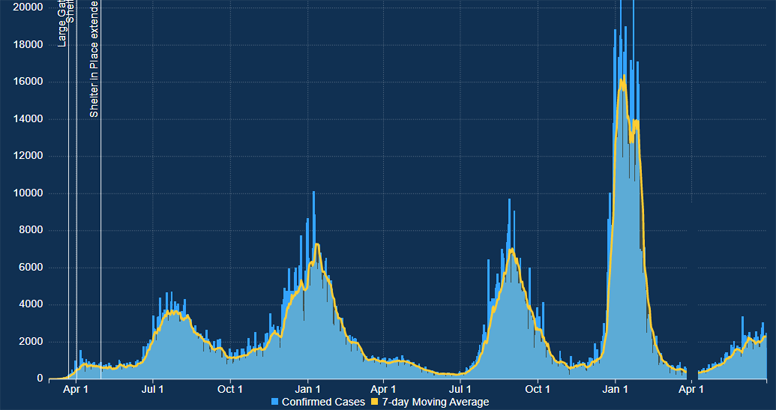
(Note that a brief period around April 1 with a reporting problem is blacked out.)
Of more interest is the death rate, which has stayed very low. In fact, the case fatality rate
has fallen quite low nationally; COVID simply isn't the killer disease that it used to be.
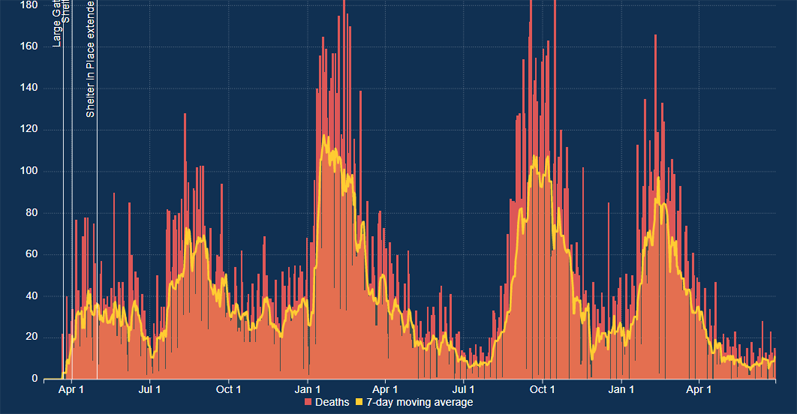
I think what has happened is threefold: we don't have a new variant of COVID this time,
most of us are well vaccinated (I have had 4 shots!), and, sadly, the people who were most
vulnerable have already died in earlier waves.
How normal is life nowadays? Well, there's little real restriction on what we do.
We wear masks in doctors' offices and certain crowded places, but apart from that, we come
and go as we please. We avoid thick crowds, of course; I hope this becomes a permanent
practice. Like most people, we are still wary, perhaps unduly wary, of travel.
However, we have become homebodies, and it's hard to break out of it. Twenty-seven and a half
months ago, when the pandemic began, my daily routine was to go to a gym, then eat lunch,
then take my laptop to the UGA Science Library to do some programming, surrounded by students.
I find it energizing to be among people who are doing similar work but not asking for my
attention.
During the pandemic I went through a long period of working at home, then switched to working at
the new FormFree office, which is still my practice. I see three to six other people there every day
but don't interact with them much; the rest of my team works elsewhere and communicates over the
Internet. I exercise by walking around the neighborhood.
Social life has scarcely resumed, although I have finally started taking Melody out to eat frequently
(rather than having food delivered); we've gone to have dinner with my nephew and his family; and we
are about to start getting together with friends occasionally.
Still, it is a more solitary life. There is, of course, the constant clamor that is Facebook —
but people generally have specific things to say (or argue about). What I miss could be
described as shallow interaction — simply seeing people and exchanging greetings
and indications of good will, without requiring information or action from every encounter.
I want to get back out, if not into crowds, then at least into humanity.
And travel, and see Atlanta, and see the grandchildren in Kentucky!
Afterthought: It is quite feasible for me to go and read or hang out on the UGA campus, but it is
strangely depopulated. Apparently, rather few people enrolled in summer classes this year.
The McBay Science Library is having its main entrance remodeled, and currently you enter it through
a labyrinthine temporary entrance (formerly a fire exit or something) which seems sufficient to keep out
most of the students. I've been there a couple of times lately, but it's empty.
Permanent link to this entry


|
2022
June
28
|
Business in time of bitter division
In view of bitter controversies caused by the sudden overturning of Roe v. Wade and the
fast-emerging evidence about the January 6 uprising, I posted this on LinkedIn this morning.
It was well received.
At this time, while our nation is torn apart by bitter controversies, I just want to say…
…that it is generally a very bad idea for companies to take sides. If they do, they risk losing some of their employees, investors, and customers.
A corporation is not a bloc of people seeking representation. It is a special-purpose association formed for the purpose of running a business. Its people’s private lives and opinions are outside its scope. People join it assuming it will carry on its stated business and not make them take positions on other matters.
One of today’s controversies is especially explosive because it cuts to the core of the question of what human rights are and who has them. It is accompanied by several side-controversies about legal reasoning and jurisdiction.
Very intelligent, well-intentioned people have come down on both sides. If you don’t realize this, you aren’t well-informed.
I am dismayed by the eagerness of some on each side to misunderstand, misrepresent, and demonize the other. That is the mark of a small mind. Like a judge in a courtroom, an intelligent person should want to know the best that can be said for both sides in any controversy. That does not imply they are both right, only that our decisions should be well-informed. It also keeps us from hating the people with whom we disagree.
Permanent link to this entry


|
2022
June
21
|
M13 and galaxies

This is last night's catch — the globular cluster M13.
Stack of 14 2-minute exposures, Celestron 8 Edge HD, f/7 reducer,
Nikon D5500(a), iOptron GEM45 mount, and the usual autoguiding
arrangement.
This time I controlled the camera with N.I.N.A. rather than BackyardNikon,
just to try it out.
This may actually be "last light" with the GEM45 mount, as a new Losmandy GM811G has
just arrived. It's still in boxes, and I don't know how soon I'll get it working.
In the upper left corner of the picture is the galaxy NGC 6207. Go halfway from it
to M13 and a little to the right, and you see another distant galaxy,
IC 4617 (magnitude 15). On the original image, before reducing it, I could see
a few even fainter galaxies in the upper right area of the picture.
Permanent link to this entry
The day the Motel 6 burned down

It's not every day you get to watch a motel burn down.
Yesterday, Melody and I, enjoying our newly regained ability to dine out as
COVID winds down, had two dates, lunch at Chicken Salad Chick (Athens)
and dinner at Sonny's Barbecue in Commerce.
Across the road from Sonny's, something was on fire.
Melody snapped this picture as we drove by the Motel 6 on Tanger Boulevard.
I hasten to add we were not in the way; the fire trucks were on the next street
to the south; Tanger Boulevard was open and completely unobstructed; and the
telephoto lens makes it look as if we were closer than we were.
So far, there are no reports of injuries, but the cause of the fire has not been
announced. It started around 6:30 p.m., when the motel had very few people in it.
Permanent link to this entry


|
2022
June
19
(Extra)
|
The galaxy M64

Here's last night's catch. Stack of fifteen 2-minute exposures with a Celestron 8 EdgeHD at f/7 and a Nikon
D5500(a) camera; GEM45 mount; guidescope; PHD2 and BackyardNikon software.
Compare to my previous attempt at the same galaxy,
which shows even more detail.
Permanent link to this entry


|
2022
June
19
|
Ship in a Klein bottle

For Father's Day, Sharon gave me a ship in a Klein bottle.
Or rather a model of a ship in a model of a Klein bottle.
In mathematics, a Klein bottle is a 4-dimensional object similar to a Möbius strip,
but in more dimensions.
The 3-dimensional glass model is only approximately like the real thing.
The biggest difference is that, where the neck bends and goes through it,
in four dimensions it doesn't really do that; the neck is present in part of its 4th-dimensional
range, and the unbroken surface, in another. It's rather like the way that in 3 dimensions,
you can jump out of a circle without touching it, but in 2 dimensions, you can't.
Sharon bought a glass model of a Klein bottle and a small toy ship, and glued them together.
Is this a ship in a bottle? Yes. Like Möbius strips, Klein bottles have surfaces that
look like opposite sides but are actually the same side.
Permanent link to this entry


|
2022
June
18
|
Thin, flexible USB cables are not for charging

[Revised.]
The USB standard has evolved in a clumsy way that almost set our house on fire.
In the beginning, USB cables could supply 5 volts at up to 0.5 amp (that is, a maximum of 2.5 watts)
to power or charge the device attached to them.
Nowadays, the powered device, via digital signals, can request more current, and even more
voltage, for fast charging. For instance, my ThinkPad T490s charges through a USB-C port
through which it requests ("negotiates"), I think, 19 volts at 3 amps. Of course, if its charger
is plugged into a USB device that hasn't made the request, all that device would get is 5 V, 0.5 A.
Two clumsy things have happened:
- Some USB cables are made of wire too thin to carry the newer, higher charging currents.
There is no way for the cable by itself to tell the device or the charger that it lacks this
capability, because the cable is nothing but wire.
- Some USB wall adapters and car adapters can deliver more than 0.5 amp without digital
negotiation. It normally does no harm; a basic electrical principle is, volts are what you supply,
amps are what you take. For example, if a 5-volt 0.2-amp device is plugged into a 5-volt power source
that can deliver 0.5 or even 3.5 amps, it will still only take 0.2 amp.
That brings us to today's adventure. Sitting in her recliner, Melody smelled something burning.
She started looking at the USB cables that she uses to charge her phone, tablet, and watch, and
one of them was hot enough to burn her hand! It was not plugged in to charge anything at the time.
She quickly unplugged it from the wall socket adapter and called me to investigate.
It was something of a freak situation, because ordinarily, any USB power source should shut down
if short-circuited. But the cable wasn't quite short-circuited. Nor did the power source shut
down as it should under an overload. So we had two things wrong:
- The USB cable apparently deteriorated over the months while handling the high current needed to fast-charge Melody's phone.
It seemed to work, but apparently, there was gradual deteriorating from overheating.
Look at the thin wires in the picture above. They must be 22 gauge,
rated to carry less than 1 amp.
- The wall socket adapter was rated to supply up to 3.4 amps willy-nilly, without digital
negotiation, and, in experiments, did not shut down when short-circuited — it simply
clamped its output at 3.7 amps.
THAT IS UNACCEPTABLE. Switching power supplies (of which this is one) should always shut down
(cut the voltage to 0) when short-circuited.
It is Chinese-made but appears to have safety certifications on it (who knows whether
they are genuine?).
In an earlier version of this article I said, know your USB cables and watch out for thin ones
that are not rated for fast charging. But after further analysis, I think the real culprit
here is the power socket adapter, which gleefully pumped 5.2 V, 3.7 A (that is, 19 watts of heat)
into something that wasn't just not digitally negotiated, it was a short circuit!
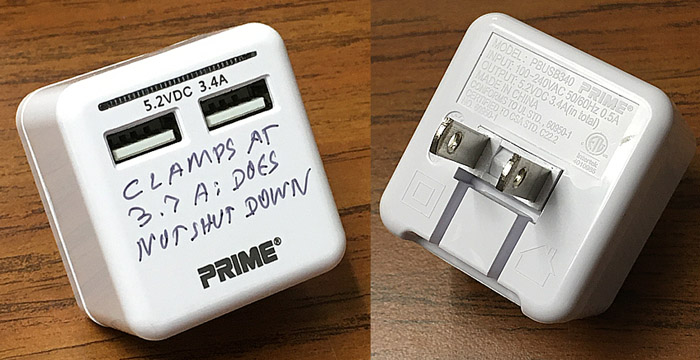
Here you see it, complete with its almost certainly bogus safety certifications.
The brand is "PRIME" and I don't know where we got it.
My warning is written on it, and next I'm going to Widlarize it
(look it up; that means take it apart destructively to see what's inside).
I'm sure, though, the problem is not a component failure, but bad design.
It works exactly the way the designer intended; it's just not safe to
attach to random USB cables.
Permanent link to this entry


|
2022
June
15
|
You don't have to use a high-DPI display mode
In Windows, a high-DPI display mode is what your new computer very likely uses.
That means the pixels on the display are much smaller (in dots per inch, DPI)
than the pixels expected by the software.
Windows is in charge of enlarging all the lettering, menus, pictures, etc.,
to fit the way the display actually works.
That gives you a crisper, sharper view.
With most newer software, high-DPI modes work very well. I've written a bit
about how to get recalcitrant pieces of software to work better
on high-DPI displays by giving Windows more information about how to magnify them.
But some software just won't play along. What then?
There is another way. You can put your graphics system itself into a normal-DPI mode.
Then the magnifying is done, uniformly, by the hardware, and the software doesn't have
to stuff pixels in unexpected places. Here's how to approach that.
Right-click on a blank area of the desktop, choose Display Settings, and choose your
computer's highest-DPI ("Recommended") resolution, together with its "Recommended"
magnification. That's probably how it's already set.
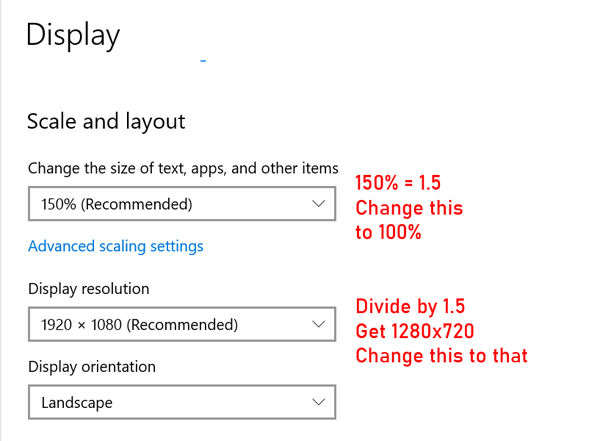
Then do the calculation described in red, and choose the resulting resolution,
with 100% size (no magnification). Presto — quirky software works normally.
What this costs you is that the overall display is not quite as sharp, but it's
still better than it would be if it weren't high-DPI. I decided that on my ThinkPad
T490s, it's well worth it. I can get Photoshop CS2 and some old astronomy software to
run properly now.
What if the calculated resolution isn't on the menu? Then choose something that is.
For instance, one of my computers runs at 3840 × 2160 × 250%.
If I wanted to put it in normal-DPI mode, dividing by 2.5 would give me 1536 × 864,
which isn't on the menu. Fortunately, 1600 × 900 is on the menu and is a very
common size, and it works fine. However, I left that computer in high-DPI mode
since I run newer software on it.
Permanent link to this entry


|
2022
June
13
Extra
|
The stained glass windows of the UGA Baptist Center

West window.
Click here to download a higher-resolution image.

East window.
Click here to download a higher-resolution image.
Today, with the help of campus minister Tommy Fountain and college friend Barbara Ellard Porter,
I photographed the stained glass windows in the Baptist Center chapel — partly.
The plainer window, the east one, was easy.
The west window, however, was covered up with curtains and panels, some of which we removed;
we'll go back and photograph the whole window when it's exposed.
The coverings were to facilitate use of projection screens, musical setups, and even
theatrical sets. The stained glass comes down to floor level and can be quite bright in
the evening sun.
It has been covered for several years, and many of the people who frequent the building are
unaware of its existence. Seen from outside, it looks like some kind of plaque, with no
color visible.
Demolition of the building has been postponed until December, and we are scrambling to find ways
to salvage some or all of the stained glass. If you are a stained glass artist or architectural
recycler and want to know more, contact me. The window is in Athens, Georgia.
UPDATE, 2025: As of mid-2025, the building has been sold to the University and is slated to be
torn down, but is still standing. I wish UGA could be persuaded to repair it and use it as something, perhaps as a
concert hall. Note that there is no specifically religious imagery in the stained glass or
anywhere else.
Permanent link to this entry


|
2022
June
13
|
The first classical music I ever heard
(Bizet scrambled?)
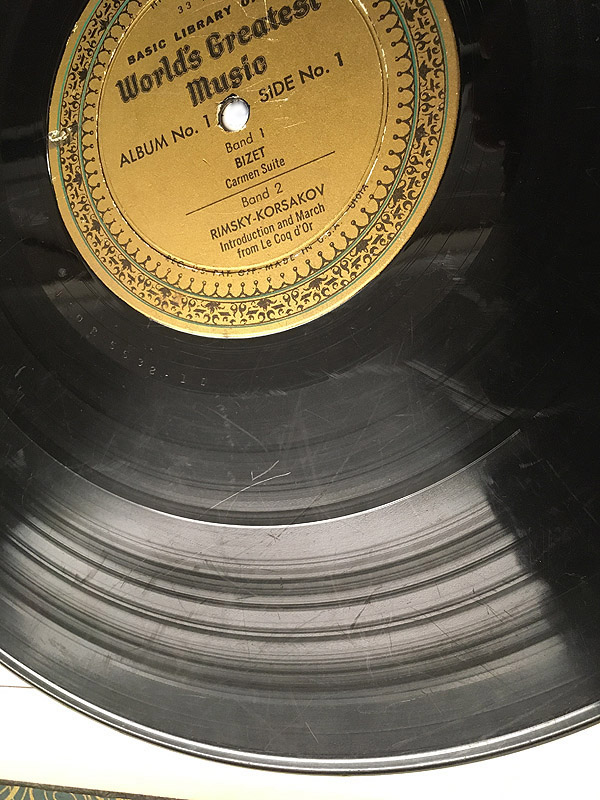
The first classical music I ever heard was Bizet's "Carmen Suite" — or so I thought.
When I was four years old, my mother, on a whim, bought me a classical record at the grocery store.
It was part of a series that was being sold there, one per week, to keep people coming back.
There were 24 in the set, but we only got the first three. The whole set is now
catalogued
on the Web.

I put it on my kiddie phonograph, played it, and liked it.
The very first piece of music appealed to me.
It was much better than "The Three Bears"
or the country music I occasionally heard on the radio.
I grew up thinking this was Bizet's "Carmen Suite." It certainly was music from Bizet's Carmen.
But on trying to track it down, I found that Bizet, or rather the man who posthumously arranged it,
had composed two Carmen Suites. Which one was it?
The answer was stranger that I could imagine. Today I was pleased to learn that despite being handled
by a 4-year-old, 5-year-old, etc., etc., the record was still playable. I digitized it and carefully
compared it to recordings of newer performances on the Web.
Here is what "Carmen Suite" on this record turned out to be:
0:00 Suite 1 mvt 5 (Les toréadors)
2:10 Suite 1 mvt 1 (Prélude)
3:20 Suite 2 mvt 1 (Marche des contrabandiers)
5:00 Suite 1 mvt 2 (Intermezzo)
7:25 Suite 1 mvt 1a (Aragonaise)
9:33 Suite 1 mvt 4 (Les dragons)
11:10 Suite 2 mvt 5 (Danse bohème)
14:28 end
That's right — movements from Suites 1 and 2, mixed and in the wrong order.
(If there's a Bizet scholar in the audience who can tell me there's method to this madness,
I'll be glad to hear from you!)
[Afterthought:] If this "suite" didn't result from a comedy of errors, maybe someone put it
together to use as a long overture, for a performance under circumstances
where Bizet's 3-minute overture wouldn't do.
Like the overture, it begins with the March of the Toreadors, and overall it is livelier than
either of the Carmen Suites.
Since Bizet died during the first performance run, and all the publishing was left to others,
I can't be sure no one published a suite or long overture that matches what I found.
Contrary to what I thought I remembered, "Habañera," the most memorable tune from Carmen,
was not on this record; I must have made its acquaintance somewhere else.
Carmen is my favorite opera for the music, but its plot does not much appeal to me —
it seems to be about people doing foolish things all the way through, and I'd actually rather
enjoy the music without thinking about the action.
Technical note:
In the picture of the record at the top of this entry, you can see variable groove spacing.
Louder passages are recorded with more widely spaced grooves than softer passages; this makes it
possible to get slightly more music on one side of an album.
This practice was once common with classical records but died out in the 1960s.
Permanent link to this entry
More about the "Basic Library of the World's Greatest Music"
This set of records has a couple of quirks that explain how it came to be sold cheaply in grocery stores.
First, the records are monophonic. By 1961, most classical music aficionados wanted stereo records.
Mono records could still be sold as educational material for students and people wanting to sample
classical music at low cost.
Second, the album covers include pages of well-written detail about the composers and the works,
but not a clue about who was performing them.
That's why I think the genesis of this series is that a publisher of mass-market reference books (apparently Funk and Wagnall's)
acquired the rights to a lot of early-1950s monophonic classical recordings, then put together the album set
at minimum cost. It was certainly a great way for beginners to learn about the world's greatest music.
It certainly worked for me.
What, by the way, was the world's greatest music? Well, tastes were different in the 1950s.
Here are the contents of the whole set:
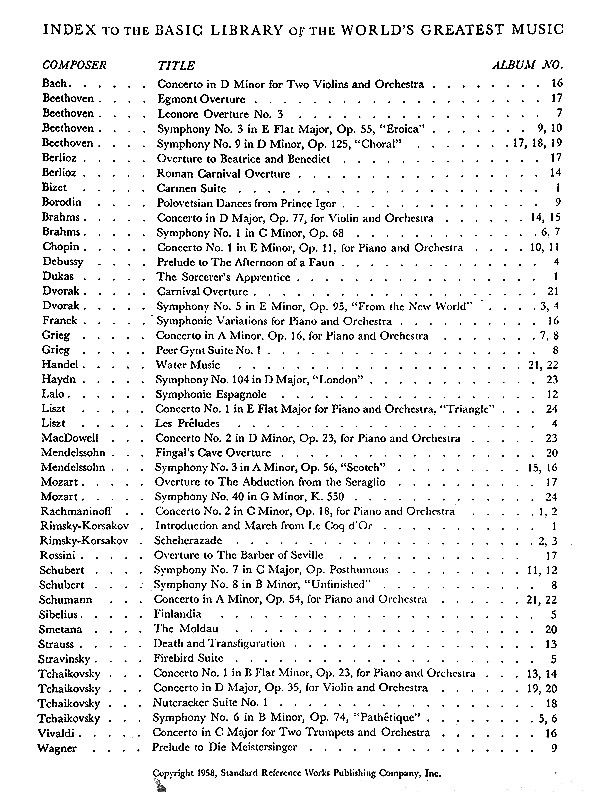
Note the baroque deficit. From the time before Mozart, we have Händel's "Water Music" (good!),
one minor work of Bach, and one Vivaldi concerto. Some years later, at a friend's house, I listened to
the Bach record in this series and recall that they made it sound way too much like Haydn or Mozart;
the precise timing of baroque music wasn't there.
In fact, baroque music was rediscovered in the 1970s, and in my student days, a lot of it was being
published for the first time. (It even influenced rock music, such as the beginning of "Stairway to
Heaven.") And there was suddenly a new willingness to acknowledge Bach as a great composer, possibly the
greatest in the western world. Recall that Bach had gone through a period of being almost unheard-of
until Mendelssohn drew attention to him; he was thought of as a clever theorist who composed illustrations
of his theoretical ideas, which modern people need not listen to.
By 1970, people were not so sure that everything "modern" was best.
The publisher may also have had to deal with a spotty selection of works available.
It seems odd to introduce Beethoven with the Third Symphony rather than the Fifth.
Permanent link to this entry


|
2022
June
12
|
The January 6 Congressional Hearings
Now that televised hearings
about the January 6 insurrection
have started, I want to point out a few of things:
- This is not a trial; we're hearing from the prosecution, not the defense;
and although it is hard to imagine that there's much innocence to be found,
someone still needs to go through all the evidence and look for contrary or
mitigating information. That, I hope, will happen at subsequent criminal trials.
- Deluded or deceived people need space to change their minds.
Now is not the time to quiz or argue with people who still take Trump's side.
They have some thinking to do.
- Genuine repentance is called for.
Those who went too far supporting Trump — not just supporting his politics,
but also lowering their moral standards to "help the right side win,"
spreading falsehoods or doubtful claims,
in some cases even ultimately
supporting these armed gangs — need to admit they're wrong and act to counteract
the harm.
Perhaps the worst sin committed by a lot of people was simply cutting loose from
reality, abandoning the fundamental responsibility to know and tell the truth,
and choosing to believe whatever someone made them imagine,
and to say whatever would get them what they thought they wanted.
If you happily lie to yourself and everyone else, you've reached the pit of dishonesty.
And there are two big things I want to know:
- What does Trump actually believe?
My recollection is that in his call to Raffensperger,
he claimed to have "won by a landslide" "in all 50 states," which defies belief and is more
than anybody else has claimed. If the election were really "stolen" it would involve only a
few votes in states he lost by a hair. His actual statements are far stranger than that.
- If the insurrection had succeeded, what was supposed to happen next?
If Trump had been sworn in, what then? He would be President, but everyone would know he
got there by violence. How would he govern a country in which maybe 80% of the people
and 99.9% of the judges believe he's not legitimate? Foreign countries that believed we
did not have a legitimate government would withdraw their ambassadors and try to get out
of treaties. Trump himself would be vulnerable to the 25th Amendment and to impeachment
at any moment. We would still be a nation with a consitution, not a monarch.
There are real limits to what a president can do if the officials and courts below him
do not consider him legitimate.
I get the impression some people believed the insurrection would suddenly usher in a new
reality in which the insurrectionists (even Buffalo Man) would be heroes and the people would
bow down to their newly installed ruler. No... no...
if you think that, you haven't been to America!
Permanent link to this entry


|
2022
June
11
|
A Chaucer parody
This needs to be preserved for posterity...
My good friend Jeff Duntemann was surprised to find an online bookseller listing one of his computer books
as being written in "Middle English." This inspired him to contribute the first two lines of the
following, and I responded with the rest:
Whan that Aprille with his shoures sote
And ye olde Pentium refuse to bote
Wyth Fryes of Sunnyvale on hir corages
Than longan folc to goon on pilgrimages.
Permanent link to this entry


|
2022
June
7
|
How my mother played the piano using only the black keys
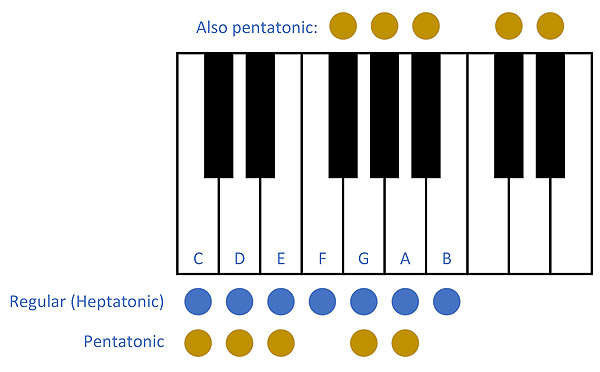
If you've studied music enough, that picture says it all.
For the rest of us, let me explain a bit.
One of the surprising things my mother taught herself to do,
growing up in rural Georgia, was to play the piano by ear – but she only used the black keys. How is this possible?
For the answer, here’s a bit of music theory.
An octave spans a total of 12 half-steps (semitones), represented by the 7 white and 5 black keys on the piano.
But the way we normally construct tunes, we don’t use all 12 half-steps.
We skip some of them in a specific pattern, represented by the white keys on the piano.
(Starting from C, skip one half-step, skip another, don't skip, skip, skip, skip, don't skip.)
Most tunes can be played using only the 7 white keys.
We call this a heptatonic (7-tone) scale.
(You thought an octave was 8 notes? The 8th one is the start of the next octave.)
If you can play a tune on the 7 white keys, you can also shift it up or down any number of half-steps.
Start somewhere other than C, but choose the keys you will use in the same way: skip a semitone,
skip another, don't skip, skip, etc.
In that case you are using some black keys, but you are still skipping half-steps in appropriate places.
That is what is meant by putting a tune into a different key.
We can thank J. S. Bach for insisting that we tune our musical instruments so that any tune sounds
equally good in any key.
Well, the 7-note scale is not the only way of cutting down the original 12-tone scale.
You can cut it down even more. Surprisingly many tunes can be played using only 5 of the white keys, a so-called pentatonic scale.
And you can shift that up or down, too.
Surprise – if you look at how they are spaced (in semitones), the black keys on the piano constitute a pentatonic scale.
And that’s how my mother played the piano.
Lame joke for music students:
I saw a poster that told students to keep alert: "Don't B flat, B sharp."
I thought a moment and replied, "B sharp? I C what you're doing there."
Permanent link to this entry
Turn off Local Normalization in PixInsight
(REVISED)
If the picture of M100 that I posted the other day looked a bit wimpy,
scroll down and look at it now.
(I'm also reprocessing some other recent galaxy pictures.)
My ability to stretch (amplify) the image was limited by a strange discoloration
which I have now tracked down and controlled.
I do my processing with PixInsight, and in some recent version of the WeightedBatchPreprocessing (WBPP)
script, it became the default for Local Normalization to be turned on.
But when it turned on, it started causing a problem.
I first thought, mistakenly, that Local Normalization itself was flawed.
I found postings on PixInsight Forum from a couple of years ago saying Local Normalization
is tricky. So I opened the discussion by saying that PixInsight should have
made it be off by default, not on by default.
Let people turn it on who want to go to the trouble of figuring out how to set it.
But in fact not nearly that much was wrong. An incorrect setting had gotten carried in,
without my knowledge, from an earlier version of WBPP. Read on...
Local Normalization is supposed to be used when stacking images that have quite different
gradients or stray light in them.
In my case Local Normalization caused a problem. Some vague discoloration and random noise in the sky background
was getting turned into colored streamers worthy of a 1970s T-shirt.
Here's what happened (and you are looking at very amplified images here):

NOTE: Local Normalization settings were wrong here.
To hide this, I had to lower the contrast in the image.
Turning off Local Normalization allowed me to stretch the image much more strongly.
Admittedly, there is some discoloration in the original — purplish in the middle,
greenish away from the middle — and I am still trying to track that down.
For a long time I thought it was a manifestation of the infamous
Nikon concentric color problem
caused by (slightly) lossy compression in the raw files, and investigated extremely
thoroughly by "Sharkmelley" on Cloudy Nights at the link I just gave.
But I am using exposures that should be below the level where lossy compression
kicks in. I'll try some further variations on the procedure, but it looks like the
discoloration might actually be in my optics or the way they reflect stray light.
In any case, I can now keep it down to a low enough level that it is normally invisible.
The explanation was surprising.
By default, Local Normalization is now supposed to be on and is supposed to be set to
create a reference image by integrating multiple images. That's what you get if, in WBPP,
you "reset all settings to factory defaults." But it may not be what you find right after
installing the latest WBPP. The reason? In earlier versions, Local Normalization defaulted
to using a single reference frame — which does not work well — and that
setting was carried over.
If I set it to create the reference image by integration, I get good results,
without the wild color swirls. But I think I'm still going to keep it turned off,
because I haven't explored how to benefit
from it.
I never intended to denigrate Local Normalization and the work that went into it.
But when you introduce a new
feature that can affect existing users, I think it's quite reasonable to turn it off by default,
so you don't surprise them.
Discussion threads that I have started:
Cloudy Nights
PixInsight Forums
wherein people will debate the issue for years to come.
Permanent link to this entry


|
2022
June
5
|
M100

(Reprocessed 2022 June 6)
Here's last night's catch, the spiral galaxy Messier 100 (M100).
It almost seems surreal when all the astrophotography equipment works perfectly.
I set up my C8 EdgeHD and GEM45 mount in the driveway, told it to aim at M100,
it did so (verifying by plate solving), turned on guiding, and started a sequence
of 2-minute exposures, 21 of which were good. (Some were lost due to an airplane
going through the picture and, later, trees getting into the picture as the
galaxy got lower in the sky. None were lost due to guiding or equipment problems.)
The crescent moon was in the sky nearby, so this is not the best image of M100
that I can expect to get; I'll go for it again.
Permanent link to this entry


|
2022
June
3
|
Setting up ASTAP plate solving with BackyardNikon/BackyardEOS
If you're looking for the missing documentation that tells you how to do this,
click here.
These are my notes.
Crucially, BackyardNikon or BackyardEOS does not know your optical
configuration, so you have to open the ASTAP app to tell ASTAP the field of view.
Permanent link to this entry
Life in early June
Georgia's latest COVID numbers look odd, and we may or may not be getting what we
wish for — a COVID surge that never rises very high. Not sure yet.
Athens and the University are surprisingly depopulated right now. If UGA's Maymester
has any students, they're not where I can see them. I've been in the Science Library
a couple of times and have practically had the place to myself.
Melody and I have been out for a few rambles. Melody's mother was recently in the hospital
in Braselton (a formerly tiny town that now houses a major medical center) and is staying with
her sister in Loganville, so Melody has been around all those places, as well as Winder.
On Sunday, we went for a drive and, inter alia, briefly set eyes on some things I had not seen since
our fondly remembered photography trip in 1976 —
the house in Braselton, the Braselton Bros. sign, and the pond near the road.
(The beautiful meadow has apparently long since become a residential development.)
That was just a quick glance, though, and we hope to do more rambling up there.
We dined at El Real in Winder, which is excellent.
Permanent link to this entry


|
2022
June
1
|
M86, M84, and other galaxies

Reprocessed 2022 June 7
Here is last night's catch, and all my new toys worked well, even plate
solving in BackyardNikon. (I'm going to be publishing some documentation on how
to make BackyardNikon team up with ASTAP to accomplish that.) Accordingly, I told
the computer to center my telescope on NGC 4387, and it did, and then I took 30 2-minute
exposures, 29 of which were well-guided. This is the result of combining all 29.
The galaxies prominently visible in the picture are:
NGC 4402, edge-on, at the top; M86 on the left and M84 on the right, the big ones;
NGC 4837, in the center; NGC 4388, more or less edge-on, at the bottom;
and NGC 4413 at lower left.
Here's what my equipment looked like as I was getting ready:
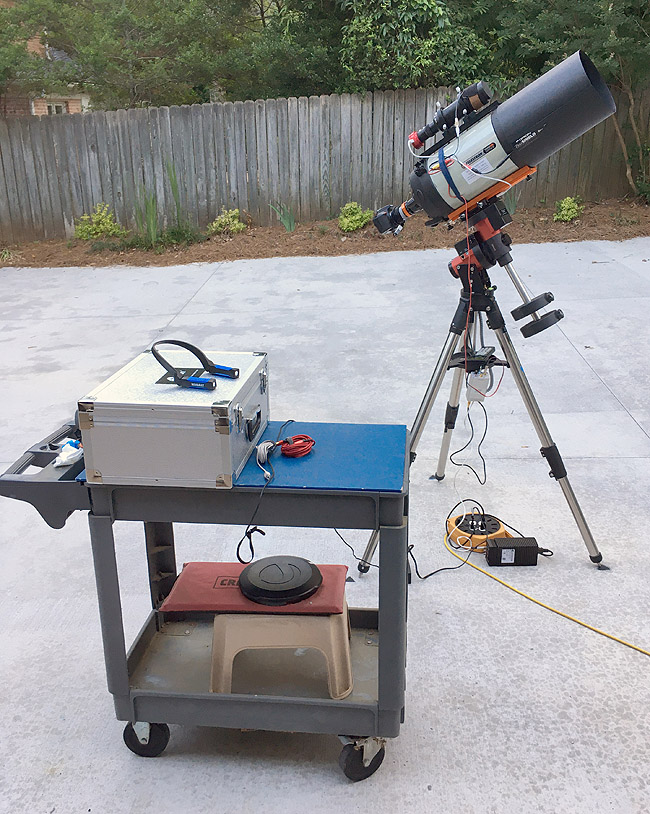
Everything's there except the computer, a laptop that was later placed on the blue surface,
and then cables were connected to it. What you see is a Celestron 8 EdgeHD
telescope (with long black dew shield, which I use to block out neighborhood lights),
Nikon D5500 camera body on the back of it, f/7 compressor between the two,
guidescope and guide camera on top of the telescope, and all of it riding on an
iOptron GEM45 mount. The computer controls both the mount and the camera.
Permanent link to this entry
Stellarium hint
In Stellarium, if you have chosen orthographic map projection (as I have),
try pressing Shift-S and then Shift-Z.
That will give you a view looking straight up, with south at the bottom of the screen.
Zoom out with the mouse wheel, and
you have a whole-sky planisphere, just like the maps in Sky and Telescope.
Permanent link to this entry 

|
|
|
This is a private web page,
not hosted or sponsored by the University of Georgia.
Copyright 2022 Michael A. Covington.
Caching by search engines is permitted.
To go to the latest entry every day, bookmark
https://www.covingtoninnovations.com/michael/blog/Default.asp
and if you get the previous month, tell your browser to refresh.
Portrait at top of page by Sharon Covington.
This web site has never collected personal information
and is not affected by GDPR.
Google Ads may use cookies to manage the rotation of ads,
but those cookies are not made available to Covington Innovations.
No personal information is collected or stored by Covington Innovations, and never has been.
This web site is based and served entirely in the United States.
In compliance with U.S. FTC guidelines,
I am glad to point out that unless explicitly
indicated, I do not receive substantial payments, free merchandise, or other remuneration
for reviewing or mentioning products on this web site.
Any remuneration valued at more than about $10 will always be mentioned here,
and in any case my writing about products and dealers is always truthful.
Reviewed
products are usually things I purchased for my own use, or occasionally items
lent to me briefly by manufacturers and described as such.
I am no longer an Amazon Associate, and links to Amazon
no longer pay me a commission for purchases,
even if they still have my code in them.
|
|





















